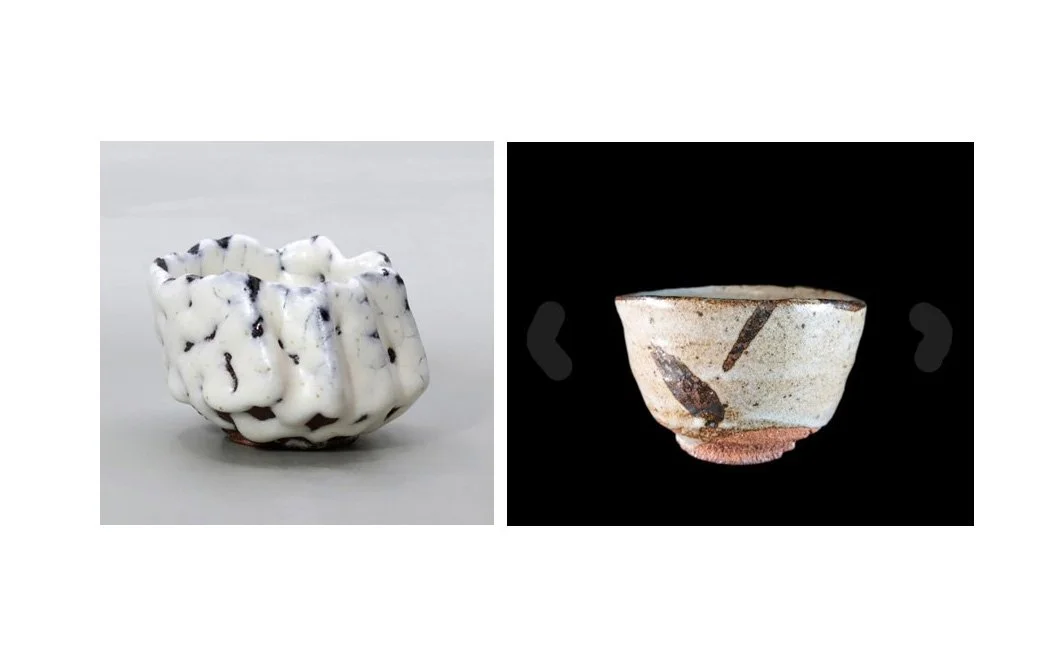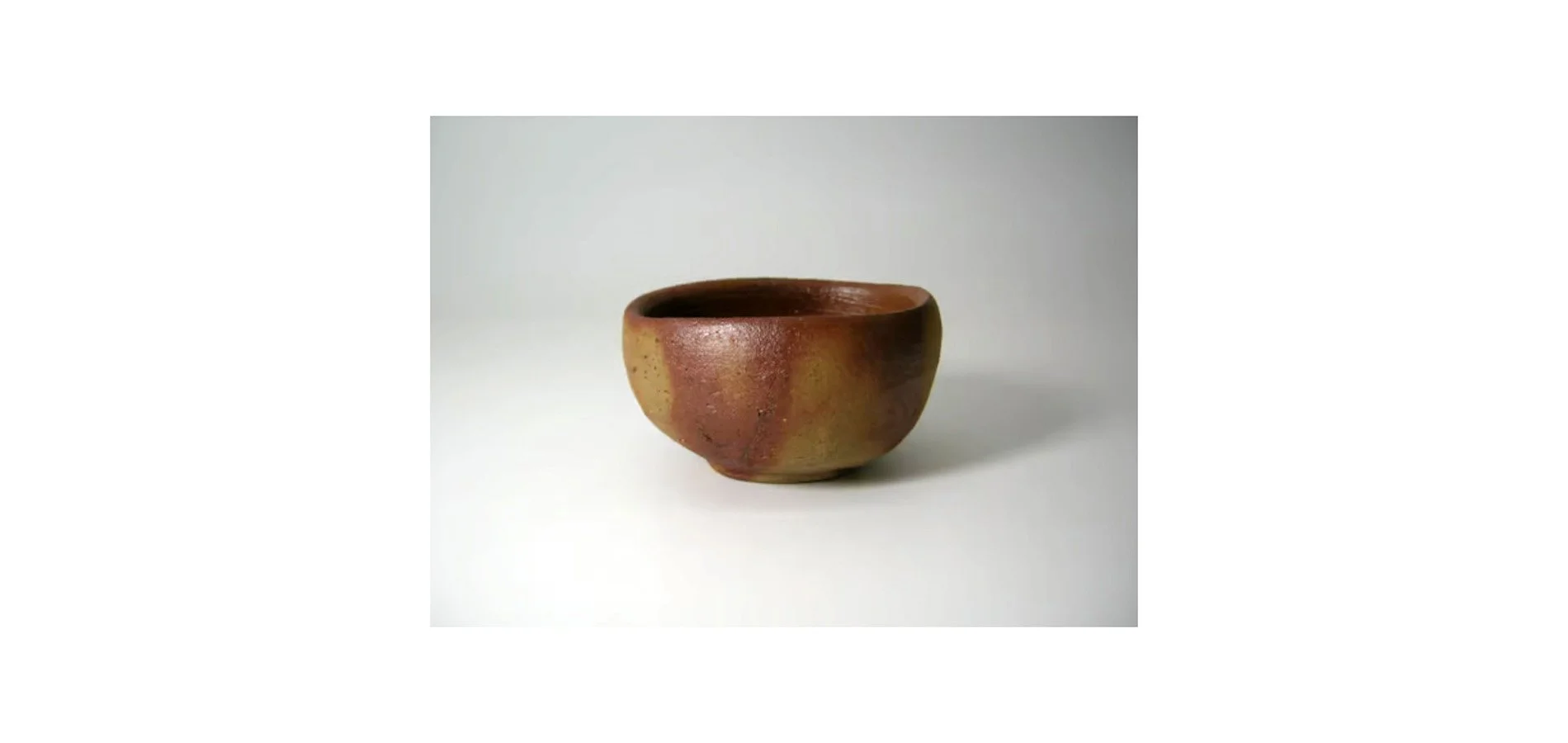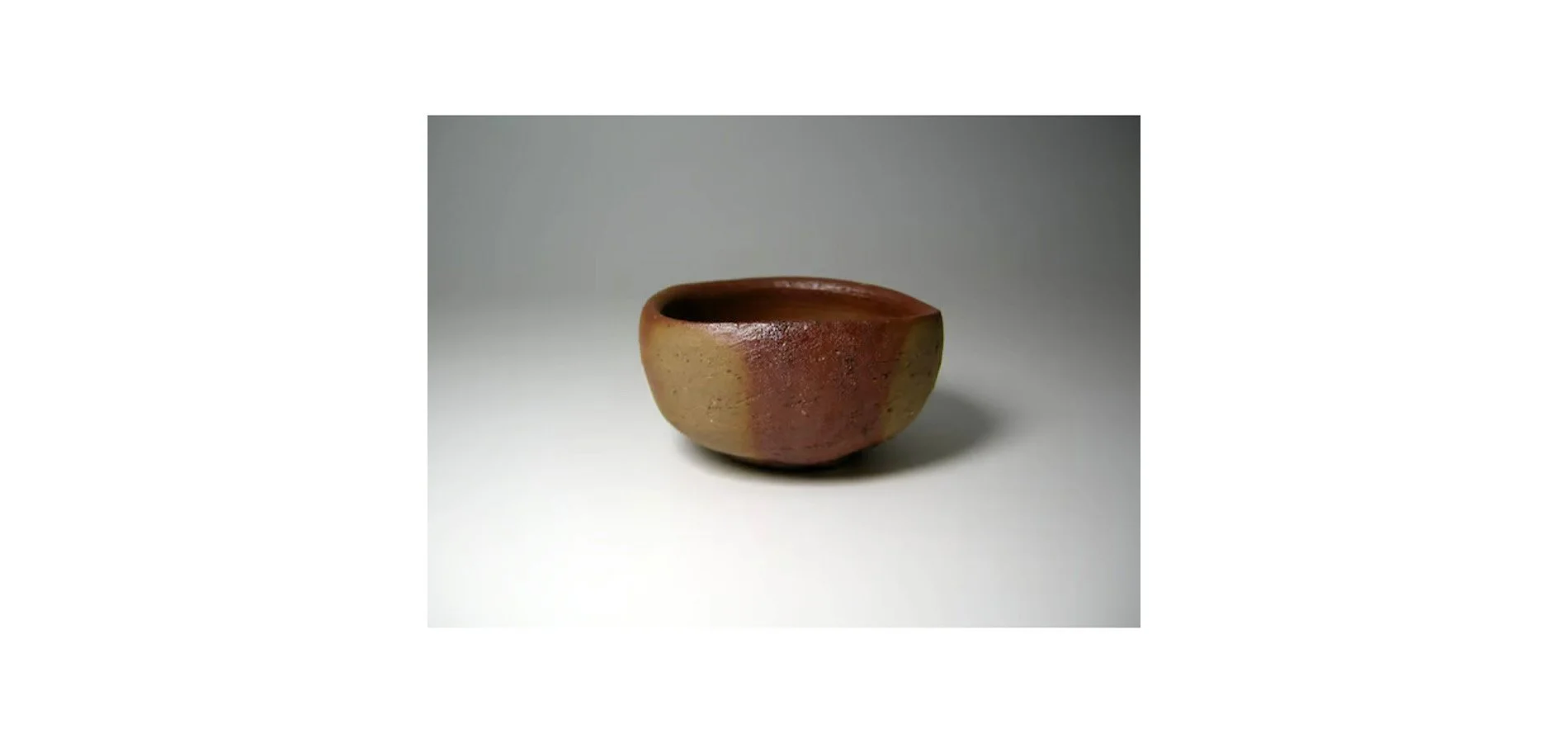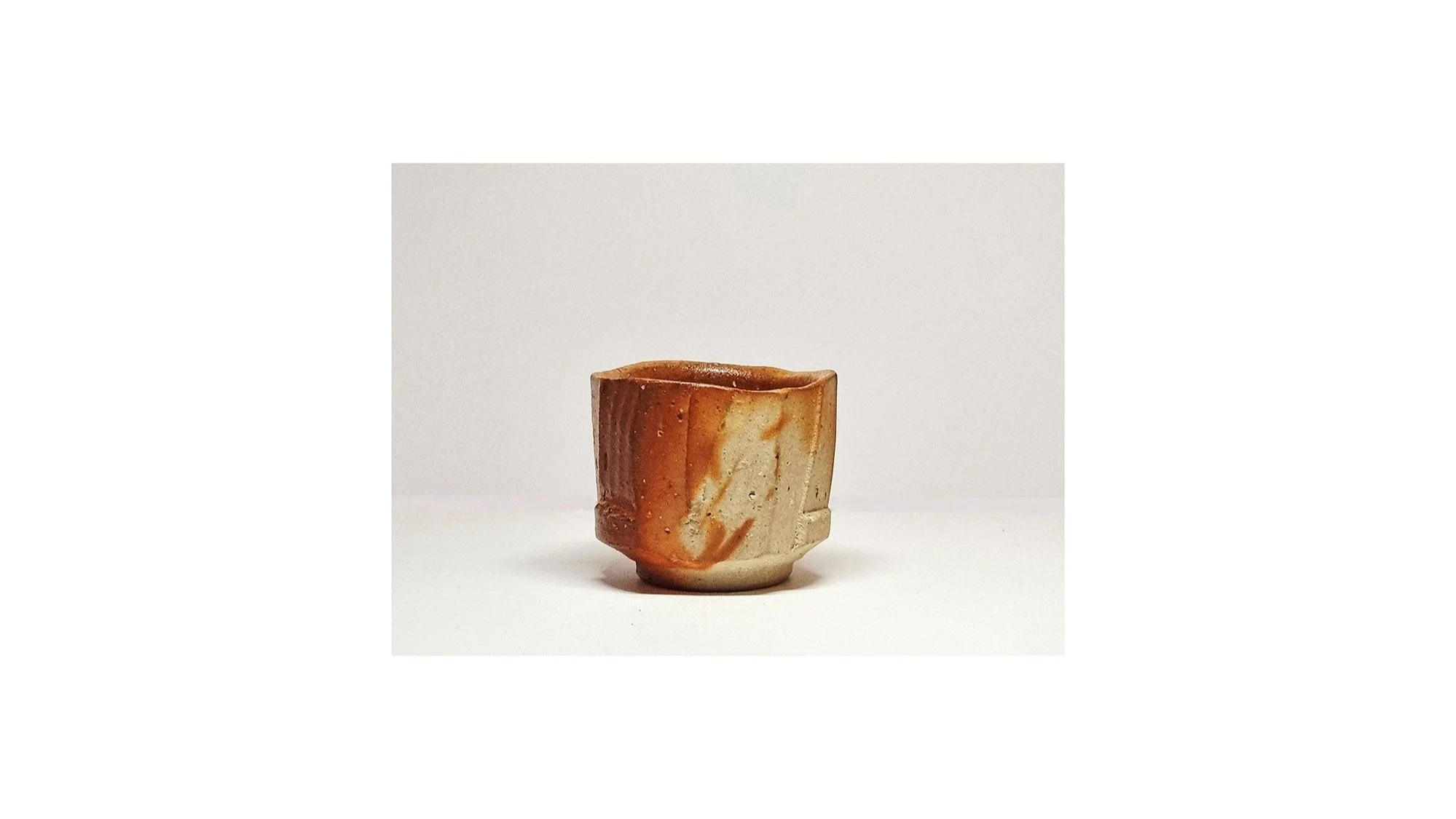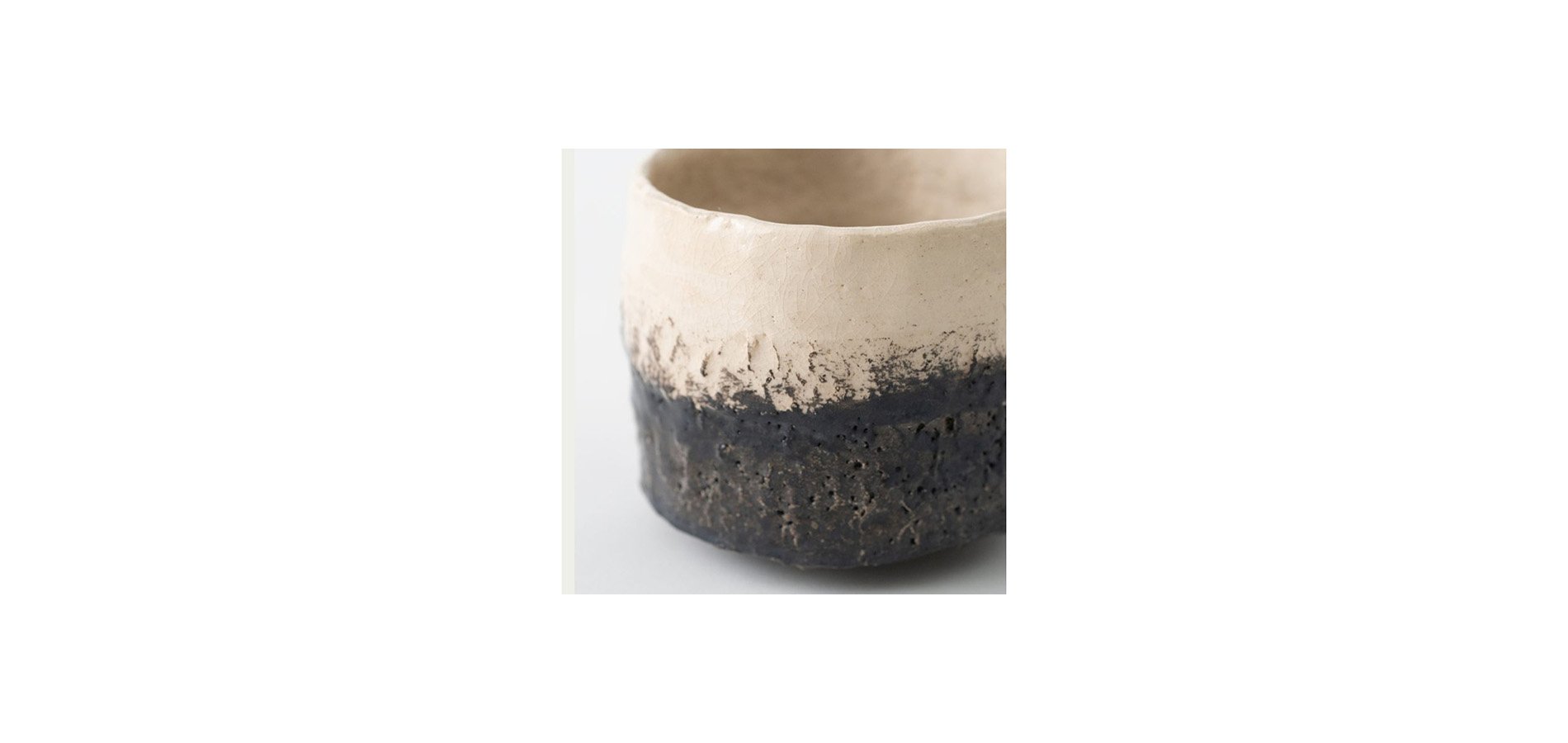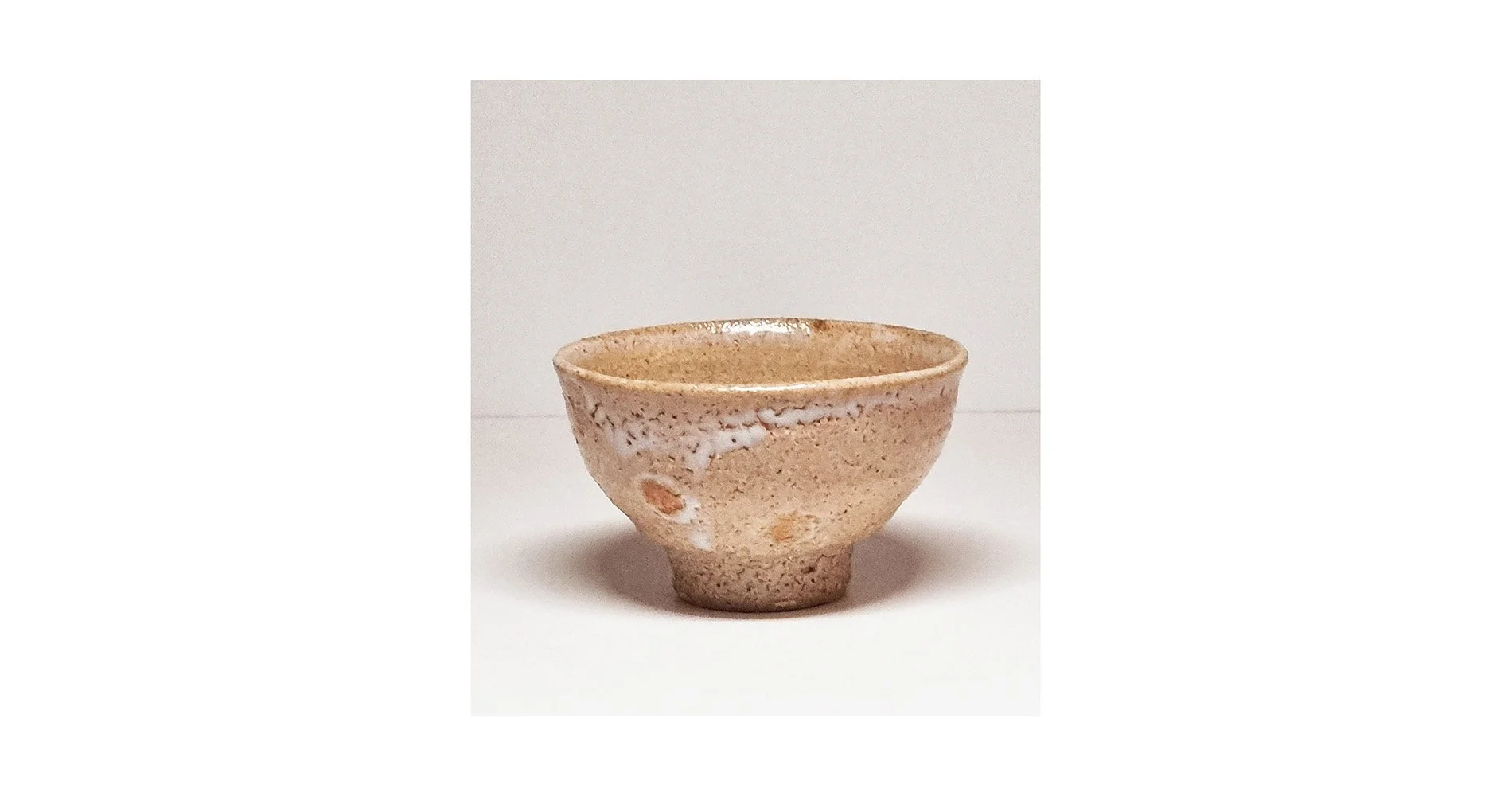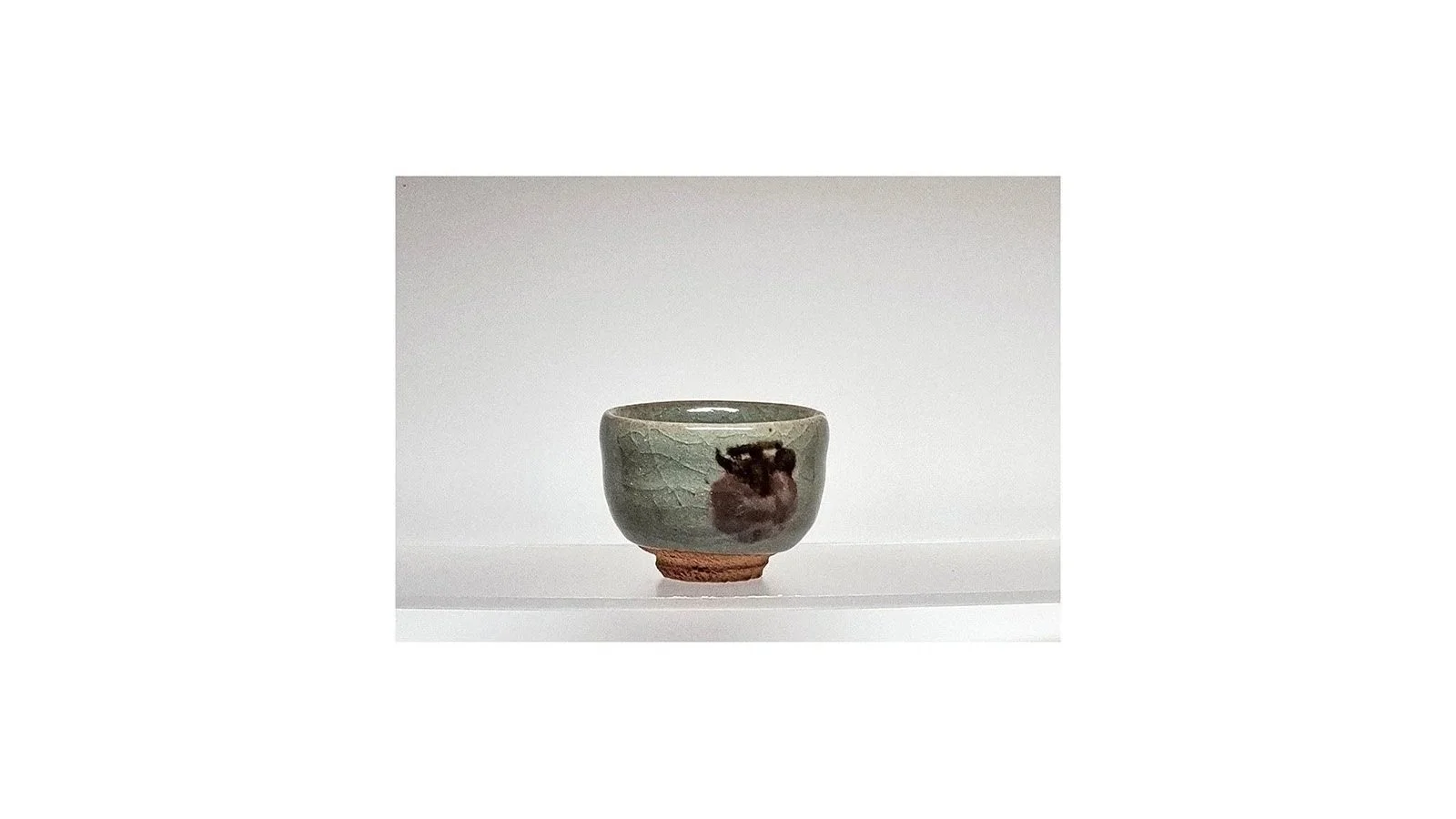SAKE CUPS
The history of sake cups (guinomi) dates to the Yayoi period more than 2000 years ago when simple unglazed cups known as kawarake were used to hold sake. In the ensuing centuries, the making of sake cups, like that of tea ware, came under the influence of Chinese and Korean pottery styles, even as local potters evolve a distinctively Japanese form for sake ware as they did for the tea bowl.
A clog-shaped sake cup partly glazed in black with some areas left unglazed for aesthetic contrast. Tsujimura Shiro is one of Japan’s most highly acclaimed contemporary ceramicists, known for his bold and spontaneous approach to pottery that often blurs the line between classical and modern expressions.
A Sakazuki sake cup by Tsjuimura Shiro featuring a shallow form and wide mouth designed to hold only a few sips, thus allowing the drinker to slowly savor the aroma of the sake. The oldest known sake cups are of this form.
A bowl-shaped sake cup in the Madara Karatsu style, with the distinctive mottled appearance due to the iron content of the clay dissolving during firing. The maker of this cap, Nakagawa Kohei, is the son of the famed Karatsu potter, Nakagawa Jinenbo (d. 2011).
A sake cup decorated with abstract patterns by the renowned Karatsu potter, Nakagawa Jinenbo (d. 2011) who is known for his texturally rich vessels that embody the essence of the wabi-sabi aesthetic. Nakagawa is succeeded by his son, Kyohei, who continues to make functional ware in the Karatsu tradition.
A modern sake cup in the old e-Karatsu style decorated with a quick brush of iron painting to suggest a blade of leaf. Karatsu potter Maruata Munehiko (b.1961) is known for his fluid brushwork and mastery of all Karatsu styles which has earned him a loyal following in Japan. Although he preserves tradition, he expresses it with a unique style that can be instantly recognized as a "Maruta Munehiko work"
A Kohiki sake cup covered with a smooth white glaze and abstract patterns where the iron-rich clay peeks through. Originating in Korea and brought to Japan in the 16th century, the Kohiki or white slip style was embraced by Japan’s warrior-tea masters for its rustic beauty, organic feel and warm milky-white texture.
A Tamba sake cup showing colors and patterns formed by natural ash glaze in tones ranging from reddish-brown and black to silvery grey. Tamba (or Tanba) in Hyogo Prefecture is one of the six ancient kilns of Japan with roots going back to the Heian period (794-1185). Born in 1971 in Hyogo, Imanishi Masahiko is known for his contemporary interpretation of Tamba ware.
A sake cup in the Seto-guro style, a type of Mino ware known for its jet-black crawling glaze. The Seto-guro look is achieved by combining high-temperature firing with the thermal shock technique of pulling out a red-hot vessel from the kiln by tongs and submerging it in water, causing the surface glaze to shrink and crawl as it cools. The style was first used for ceremonial tea bowls during the Azuchi-Momoyama period (1573–1603) and continues to be produced today.
Hayashi Ryoji, is a master potter based in Toki city, Gifu Prefecture, the heart of Mino ware. This cup was made when he was in his eighties.
A Kutsugata (clog-shaped) sake cup showcasing wood ash glaze and hidasuki (flame mark) patterns created by wrapping the cup in rice straw before firing in a wood kiln. Born in Akita Prefecture in 1962, Osawa Tsuneo has won many awards for his mastery of soil mixing and controlled firing that gives his vessels a strong rich tone.
Shaped like a mini chawan, this sake cup has a predominantly dark ash-glazed finish. The Botamochi (rice ball) pattern that resembles an enso is created by placing a circular disc or substance on the piece before firing.
A faceted sake cup by Shibuta Toshiaki, an award-winning ceramicist based in Okayama, featuring vivid hidasuki patterns created by wrapping rice straw around the piece before firing. When alkaline in the straw reacts with the iron-rich clay body, striking orange and scarlet flame marks can result as seen here.
An angular-shaped sake cup with prominent flame cord marks. Born in Tokyo, Hiroshi Toyofuku works in Okayama Prefecture, exclusively making functional Bizen ware that have a distinctive contemporary flair.
Angular-shaped sake cup by Toyofuku Hiroshi formed by piling strings of clay into shape and then firing the vessel in a wood-fired kiln. The botamochi (rice ball) patterns were created by covering specific areas to shield them from the kiln flames.
A petite earth-tone sake cup, the surface decorated with abstract landscape images. Matsumoto Yoshio lives in Nakatsugawa in the southeastern corner of Gifu Prefecture, a mountainous area known for spectacular gorges and Edo-period postal towns.
In the 16th century, the eminent artist and potter Ho’nami Koetsu created a tea bowl using only two colors: black and white to evoke the grandeur of Japan’s sacred, snow-capped mountain, Mt. Fuji. This sake cup by Yanashita Hideki pays tribute to Koetsu’s masterpiece by replicating the design on a smaller scale. Born in Tokyo but now living in Iga, Mie Prefecture, Yanashita Hideki studied under Sadamitsu Sugimoto, a leading Iga and Shigaraki potter. He currently produces works in a range of styles that expresses the notion of wabi-sabi.
A cylindrical sake cup in umeiro (plum color) Shino glaze with an underglaze of abstract iron oxide painting. Born in Gifu Prefecture in 1976, Suzuki Shinji’s approach to making ceramics balances tradition with a rebel spirit that makes his work refreshingly modern. The umeiro purple Shino glaze is a signature of his practice.
Resembling a mound of rock, the surface of this sake cup is draped in an unusual combination of blossom pinks and grey Shino. Born in 1971 in Gifu Prefecture, Hayashi Yuka Hayashi's work shows a deep respect for the Shino tradition in Japan. Her work has an aura of strength balanced with a softness that make her pieces appear both rugged and gentle at the same time. She is a regular exhibitor in Japan and is the recipient of numerous awards.
A sake cup by one of Japan’s true ceramic masters, executed in the classic style, with a milky white background serving as the canvas for abstract paintings of nature in quick, gentle brush strokes.
Born into a family of pottery masters dating back to the late Edo period, Kato Takuo studied ceramic art under his father Kobe Kato and in 1965 travelled to Finland to continue his studies. There he concentrated on Persian ceramics found at ancient Iranian kiln sites and became a leading figure in the restoration of Persian lusterware. In 1991 he won an award from the Japanese Ceramic Society and in 1995 he was designated as a Living National Treasure for his mastery of (Sancai) three-colour techniques.
Crafted in the Ido style using Daido-tsuchi clay, this Hagi sake cup has a conical shape and a bamboo stem-like foot. The surface radiates a soft loquat hues, accented by the potter’s fingerprint marks, revealing the coarse Hagi clay beneath. These elements beautifully convey the distinctive charm of Hagi ware, one of the most prized pottery styles in Japan, memorialized by the common saying “Raku first, Hagi second, Karatsu third.”
Born in Yamaguichi Prefecture, Tori Yoshino is a contemporary ceramic artist known for his expertise in the Hagi tradition, particularly his use of Daido-tsuchi clay which creates the distinct loquat-like hue on his pieces.
A petite sake cup with a glossy crackled glaze and iron-brushed painting of persimmons that evoke the ephemeral beauty of the changing seasons. Tamura Koichi was a potter highly influenced by the Mingei movement. He is renowned for his iron underglaze decoration (tetsu-e), a technique exemplified by this sake cup and for which he was given the title of Living National Treasure.
This sake cup is a perfect embodiment of the Japanese notion of beauty in the ephemeral, as captured by the phrase, Mono no aware (the poignant awareness of the impermanence of things). Covered in a matte white glaze, the cup has scarcely any embellishments apart from one spot which is painted with what appears to be a butterfly in mid-flight. With this expressive gesture and the abundance of negative space, master potter, Tsujimura Shiro shows why he is one of the most respected and popular ceramic artists in Japan today.
An irregular-shaped sake cup with carved ridges on the surface, glazed in hues of grey, blue and brown that gives it a jewel-like appearance. A late comer to pottery making, Kenji Takenaka made up for lost time and is currently regarded as one of the most innovative Bizen potters in Japan, known for his expressive use of glazes and decoration that breaks with traditional Bizen ware.
This sake cup is an artistic blend of the old and the new. The slanted mouth and the sporadic drips of blue glaze over the dark body are modern twists to the conservative style of traditional sake ware. Trained and based in Tokyo, Aoi Motoba (b. 1995) represents a new generation of ceramist artists making works that are testing the limits of clay.
Two sake cups showcasing the unique layered glazed style of Miyashita Zenji who was born in Kyoto. In the early 1980s, he developed his well-known technique of applying thin, layers of clay tinted in gradated hues of mineral pigment that evokes landscapes of distant mountains or ocean waves. For most of his career, he was affiliated with the Seitōkai and the Nitten group, exhibiting in their annual competitions, which he won 18 times. Miyashita’s works are held by major museums throughout the world, including the Metropolitan Museum of Art in New York and the Minneapolis Institute of Art.
Within a tight space constraint of a sake cup, Akira Satake has created a captivating landscape that alludes to waves crashing against rocks. Born in Osaka, Akira is a Japanese-American ceramic artist working in Swannanoa, North Carolina. His works are widely exhibited and sought after by collectors and museums. Among his honors is a National Award for Excellence in Contemporary Clay awarded by The Philadelphia Museum.
A vermillion sake cup marked by ridge lines from top to bottom like traces of human or natural topographies. Born in Tokyo, Yanashita Hideki studied under the Iga master, Sugimoto Sadamitsu, and works in a diverse range of ceramic styles, including Raku, Ido and Oribe, using restrained forms and colors to express the language of wabi-sabi.
With its irregular shape and a surface covered with thick straw-white glaze, this sake cup beautifully evokes a landscape with snow piled high. Other than the skilful moulding of the clay and the application of the glaze, the texture of this sake cup is entirely the product of what happens when fire and glaze interacts in the kiln environment.
Born in 1948, Nishihata Tadashi comes from a long line of distinguished Japanese ceramists in the Tachikui area between Osaka and Kyoto, historically known as Tamba, one of the six ancient kiln sites. His works reflect his knowledge of these ancient techniques as well as his keen sense of modern aesthetics, making him a master of contemporary Tamba ceramics.
